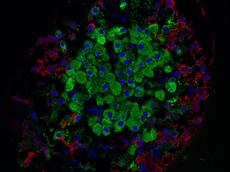MicroRNA protects beta cells
A decade ago, biologists did not know that microRNA existed. Now it has become clear that short, noncoding RNAs regulate numerous important processes in our bodies. One new example is miRNA-375. Without this molecule the beta cells in the pancreas degenerate, resulting in diabetes.

Anyone who studied biology 10 or 15 years ago will not have learned about microRNA. These short RNA strands were only discovered 10 years ago. Since then, research has discovered significant new biological mechanisms. Within a short period biologists identified, among other things, all of the genes that encode microRNAs. These RNAs regulate not just individual genes, but as many as 50 to 100 genes at the same time. The short RNAs, which have imperfect sequence complementarity to messenger RNAs, are found specifically in certain tissue or even cells. This is why microRNAs are of interest to the pharmaceutical industry, in particular for the treatment of metabolic diseases and cancer.
A balance of opposites
A research group led by Markus Stoffel, Professor for Metabolic Diseases at ETH Zurich, has demonstrated in the specialist journal PNAS that a certain microRNA could play a role in the development of diabetes. Five years ago, Stoffel and colleagues already discovered ‘miR-375’ in the beta cells, which are located in the Islets of Langerhans in the pancreas. miR-375 is a microRNA that is highly enriched in those cells. Research has now shown that this is necessary in order to maintain the balance between beta cells and alpha cells.
Beta cells play an important role in diabetes. They produce insulin, a hormone that decreases the blood sugar level after eating by storing glucose in the liver and other organs. Without insulin, the blood levels of glucose rise. When the body is fasting, glucagon, a hormone that has opposing actions to insulin, causes the liver to convert its stores of glucose and release these into the bloodstream. This can result in excess glucose levels in the blood.
Beta cells die without miR-375
Professor Stoffel’s research team found that miR-375 is essential for beta cells to survive, grow and divide. A lack of miRNA-375 causes the beta cells to die, while the producers of glucagon – the alpha cells – increase in mass. The scientists also discovered a link between this RNA strand and type 2 diabetes. The beta cells of obese mice contain more miR-375 than those of normal mice. When the researchers removed the gene that encodes miR-375, the obese animals developed diabetes, because their livers produced glucose and pumped it into the blood in an uncontrolled manner, however, the muscles and fat cells were unable to absorb the glucose.
The explanation for this phenomenon is that the beta cells of obese animals can multiply and expand, thus producing more insulin in order to overcome the insulin resistance of muscles, fat and liver. The beta cell mass can increase up to five-fold. As a result, glucose levels in the blood remain normal during this stage. However, if miR-375 is not present, the beta cells collapse leading to a reduced beta cell mass, which is no longer capable to compensate for the defect in insulin action. One reason for this development is that miR-375, a regulator of numerous growth factors in the beta cell, restricts the process of pancreatic beta cell proliferation. Without miR-375, the number of beta cells reduces over time. The result is a lack of insulin, which in turn leads to diabetes.
Antagomirs silence mRNA
MicroRNAs are important elements that can regulate entire networks of genes. This type of regulation has remained more or less stable in the course of evolution. If it were possible to influence the expression of miRNA, it could in theory be possible to manipulate the electrical circuits of cells and organs in such a way as to modify certain biological reactions or the development of diseases. These properties make microRNAs attractive as a therapeutic concept, setting them apart from traditional drugs.
For example, the short RNA strands can be inactivated in a specific
manner. The researchers refer to microRNA inhibitors as ‘antagomirs’.
Basically, an antagomir is also a piece of RNA that fits into the corresponding
microRNA similar to a key in a lock. They can be produced synthetically and
have slightly modified components as well as cholesterol attached. This
prevents rapid degradation and facilitates uptake in cells. Antagomirs bind
perfectly to the corresponding miRNA, destroying them in an efficient and
specific manner. While it is not yet clear whether antagomirs can be used to
silence miR-375, Markus Stoffel expects pharmaceutical applications of this and
other microRNAs for the treatment of diseases in the future.
References:
Poy MN et al. miR-375 maintains normal pancreatic
alpha- and beta-cell mass. Published online in PNAS, March 2009, doi:
10.1073/pnas.0810550106
Poy MN et al. A
pancreatic islet-specific microRNA regulates insulin secretion. Nature Vol.
432, 226 - 230 (11 Nov 2004), doi: 10.1038/nature03076
Krützfeldt J, et al. Silencing of
microRNAs in vivo with "antagomirs". Nature Vol. 438, 685-9 (30 Oct 2005),
doi:10.1038/nature04303







READER COMMENTS